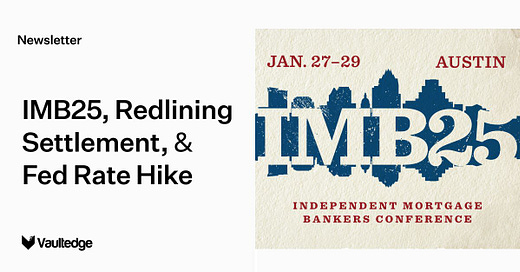Streamline Your Mortgage Operations at IMB25 in Austin Jan 27–29 with Vaultedge, Mortgage Applications Decline, Fed Rate Impact
A weekly round-up of key insights, trends, and updates in mortgage operations, regulatory changes, and market conditions.
What's Included:
Vaultedge showcases AI solutions at IMB25 in Austin (Jan 27-29) to streamline mortgage operations.
DOJ settles $1.75M redlining case with The Mortgage Firm, addressing lending disparities.
Mortgage applications drop as high interest rates and affordability challenges persist.
Fed rate decisions and rising Treasury yields contribute to higher mortgage rates.
Here’s a complete low-down 👇
Before you move on …
We would love, if you could subscribe to our newsletter.
Streamline Your Mortgage Operations at IMB25 in Austin, Jan 27–29 with Vaultedge
The Independent Mortgage Bankers Conference 2025 (IMB25) in Austin, Texas, from January 27–29, promises an exciting lineup of sessions and networking opportunities for professionals in the mortgage industry. Key sessions to attend include the IMB Quarterly Report and Forecast, offering market insights for strategic planning, and Crossing the Generational Divide in the Mortgage Industry, which highlights strategies for engaging multi-generational teams.
Other must-attend sessions explore Stan Middleman’s TPO growth strategy, financial management practices for profitability, and the latest technology trends reshaping lending operations. Vaultedge, a leader in AI-powered document processing solutions, will be attending IMB25 to showcase innovative tools designed to streamline operations for independent mortgage bankers.
Our flagship product, Vaultedge DocAI, automates document indexing, data extraction, and validation, reducing manual effort and improving loan cycle efficiency. Whether you're looking to expedite underwriting, maintain compliance, or explore the potential of digital lending APIs, Vaultedge can help elevate your business in 2025 and beyond….Read More.
Connect with Vaultedge CEO Murali Tirupati at IMB25 to discuss how AI-powered document processing can transform your operations. Book a meeting here to secure your spot.
DOJ’s $1.75M Settlement With The Mortgage Firm Highlights Referral Network Oversight Failures
The Mortgage Firm, a non-bank mortgage lender based in Altamonte Springs, Florida, recently agreed to a $1.75 million settlement with the Department of Justice (DOJ) to resolve allegations of redlining in Miami-Dade County. This marks the DOJ’s third redlining settlement under its Combatting Redlining Initiative. The settlement includes establishing a loan subsidy fund, conducting a Community Credit Needs Assessment, and enhancing fair lending training, among other measures. Unlike previous settlements involving other firms, The Mortgage Firm was not required to pay a civil money penalty.
The DOJ’s investigation revealed significant disparities in The Mortgage Firm’s lending practices between 2016 and 2021. Only 30.4% of its mortgage applications came from majority-Black and Hispanic neighborhoods, compared to 59% for peer lenders. Further, the firm’s failure to hire diverse loan officers, translate its website into Spanish, or target minority communities through advertising underscored the alleged discriminatory practices. Internal emails referring to minority neighborhoods in derogatory terms further supported the claims of intentional redlining.
This case highlights broader concerns about referral networks and the disparate impacts they can create. Critics argue that regulatory efforts to address redlining risk conflating discriminatory practices with demands for race-based initiatives. The settlement underscores the DOJ's commitment to combating inequities in lending and ensuring equal access to credit for all communities… Read More.
Mortgage Applications Decline as Interest Rates Stay High to Open 2025
Mortgage applications have dropped at the start of 2025 as rising interest rates continue to discourage homebuyers. The Mortgage Bankers Association (MBA) reported a 3.7% decline in applications for the week ending January 3, 2025, with the 30-year fixed mortgage rate hitting 6.99%, the highest since July. The increasing rates are putting a strain on the housing market, leading to reduced demand for new mortgages.
Purchase applications, which are a key indicator of homebuyer activity, fell 7% on a seasonally adjusted basis, marking the lowest level since February 2024. Although unadjusted purchase applications surged by 43% due to seasonal factors, they were still 15% lower than the same week last year. Meanwhile, refinance applications showed a slight 2% increase from the previous week but remain 6% lower compared to 2024.
Despite the mixed movement in interest rates across different loan types, the affordability challenges persist for homebuyers and those looking to refinance. As mortgage rates remain elevated, many are facing difficulties in entering or moving within the housing market. The latest trends highlight ongoing pressure on both the purchase and refinance sectors, signaling a tough year ahead for the housing market in 2025… Read More.
How the Federal Reserve’s Rate Decisions Affect Your Mortgage
The Federal Reserve’s interest rate policies have a significant impact on mortgage rates, but they do not directly control them. In 2024, the Fed lowered its interest rate target three times, leading many to hope for a drop in mortgage rates. However, experts suggest that rates will likely stay between 6.5% and 7% in the near future, which offers little relief for homeowners seeking lower mortgage costs.
Mortgage rates are more closely tied to long-term government borrowing rates, like the 10-year Treasury note yield, rather than short-term Fed rates. Recently, rising Treasury yields, influenced by potential fiscal policies from Washington, have put upward pressure on mortgage rates. Additionally, the Fed’s management of its mortgage-backed securities portfolio contributes to mortgage rate fluctuations. During the pandemic, the Fed engaged in "quantitative easing" by purchasing large amounts of mortgage-backed securities to stimulate the economy, which brought mortgage rates to historic lows.
However, the Fed's shift to "quantitative tightening" since 2022—reducing its asset holdings—has had the opposite effect. This process increases the spread between mortgage rates and Treasury yields, leading to higher rates. As a result, despite the Fed's rate cuts, mortgages remain expensive for homebuyers and refinancers…. Read More.
This wraps up our issue for the week.
We've covered the latest developments in the housing market this week. Keep informed with our expert analysis and industry insights.
Subscribe now to stay ahead and delve deeper into these topics and more in our newsletter.




